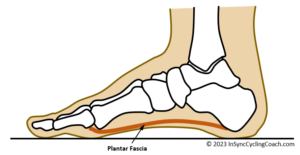The importance of arch support for cyclists
The basis of a good bike fit is the foot-pedal interface. There are 26 bones in the foot and during the power phase of a pedal stroke, 19 of them are actively transferring force to the pedal. To do so efficiently and painlessly, the foot needs effective arch support.
The Special Case of Cycling
The construction of the foot, in particular the arch, has evolved over millennia to support the entire body-weight. Hence we are perfectly adapted to walking and running.
The bike though, has existed for less than 150 years and (when ridden with clipless pedals) means the body is locked firmly into a fixed position. This is the fundamental problem that led to the evolution of Bike Fit: fitting a vast array of slightly squidgy human beings to a very rigid, symmetrical machine.
Before we delve into the issues caused by being locked in a rigid position, we need to talk about something called proprioception.
Proprioception
Proprioception, otherwise known as kinesthesia, is your body’s ability to sense movement, action, and location. The body uses proprioceptors which are specialised sensory receptors on nerve endings found in muscles, tendons, joints and the inner ear. Proprioceptors detect subtle changes in the environment, movement, position, tension and force. The main function of proprioception is to prevent injury.
In order to facilitate walking, running or cycling, the brain needs to know which muscles to fire and in what order. It reaches these decisions through proprioceptive feedback from (predominantly) the feet, more specifically through plantar fascia tension.

The plantar fascia is a band of tissue (fascia) that connects your heel bone to the MTP (metatarsophalangeal) joints. As we walk and run, plantar fascia tension changes, providing effective proprioceptive feedback to the brain. Conversely, when we press down on the pedals through a typical cycling shoe, there is little or no change in plantar fascia tension. This is because (almost all) cycling shoes have an arch support which is so flimsy there is little or no meaningful contact between the insole and the arch of the foot. By meaningful, I mean the insole provides little or no resistance to the compression of the arch, caused by pressing down on the pedals. This means that when cycling, the brain does not get the proprioceptive feedback it needs to determine where the feet are in space.
The Problems caused by poor arch support
So why does this matter? There are two main side effects.
Firstly, over time the muscles of the foot fatigue or atrophy, causing the bones to collapse onto the nerve endings and blood supply. Not addressing this early enough can lead to severe problems such as plantar fasciitis (inflammation of the plantar fascia), and Moreton’s neuroma (numbness and/or tingling in the feet or toes). Other indications of damaged foot muscles are temperature control-issues where the feet are either too cold or hot (so-called ‘hot foot’).
Secondly this lack of proprioceptive feedback, combined with the fact that the forefoot is locked into the pedals, frequently leads to asymmetrical compensations. When the brain is unsure about the position of the feet whilst cycling, the only accommodation the body can make is at the knees and hips.
Ever wondered why you sit off-centre on the saddle? Or maybe you’ve noticed that one knee kicks-out at the top of the pedal stroke? These are typical responses the body makes to compensate for lack of awareness of the feet’s position in space, which in turn is largely (but not exclusively) due to poor arch support.
So which type of arch support should you use?
By providing the arch with firm, but flexible support, we allow good power transfer and start to provide the brain with that positional feedback it’s been starved of with conventional insoles.
I categorise them in three types:
1. Off-she-shelf insoles
These are are a cheap and effective solution. The difficulty is finding a pair the right size, with the right support in the right place.
Pros: Low cost. Easy to install.
Cons: No adjustment of position of the arch support. Difference levels of support between left and right not possible. No flex.
2. Heat mouldable insoles
Heat-mouldable insoles provide an excellent solution. They can be tailored exactly to the contour of each foot. They are a one-off solution though and once made can’t be altered.
Pros: Fully customisable.
Cons: Can be expensive. Require an experienced fitter and can’t be modified. No flex.
3. Customisable insoles
My favoured solution is fully customisable insoles from G8 Performance. They provide, in my opinion, the best of the other options. Fully customisable, they offer multiple levels of arch support for each foot independently as is the position fore-aft and medial-lateral. They also, crucially, allow the foot to flex in a natural way whilst still supporting the arch.
Their real party-trick though is that the supports can be swapped-out (or moved) should you require a different level of support a few months down the line.
Pros: Highly customisable for each foot. Arch support position and level can be changed post-fit.
Cons: May not be suitable for very high power riders e.g. track sprinters.
Summary
So does everyone need custom arch support? Possibly not, but according to bike-fit guru Steve Hogg, 97% of people do!
In my experience of fitting custom insoles, people immediately feel a big difference in the comfort of their feet. The phrase I hear most commonly used is “I feel more connected to the pedal”.
Whilst it cannot cure all bike-fit related problems, I believe it is a strong starting point and makes a huge step towards complete foot correction. That’s why fitting custom insoles is Step 1 of my Advanced Foot Correction and Complete Bike Fit services, followed by shimming and wedging; but that’s a topic for another post.

